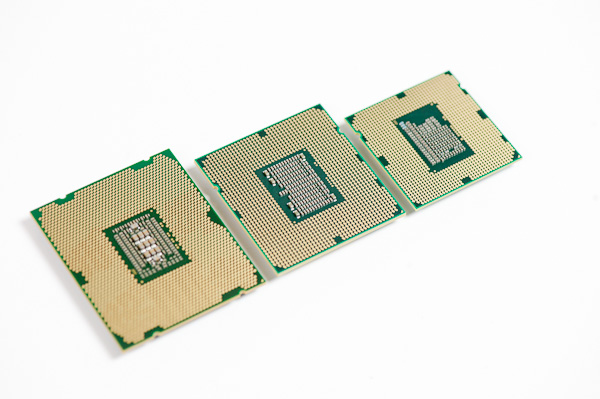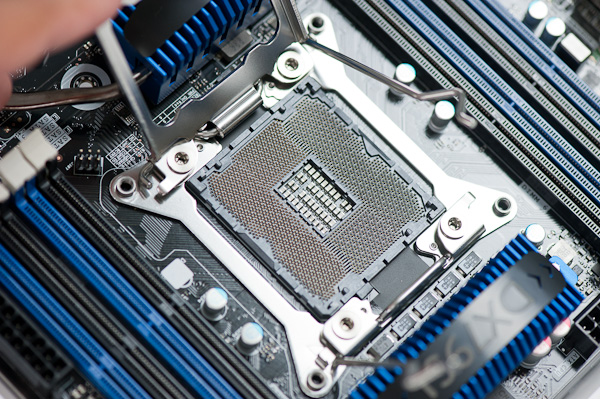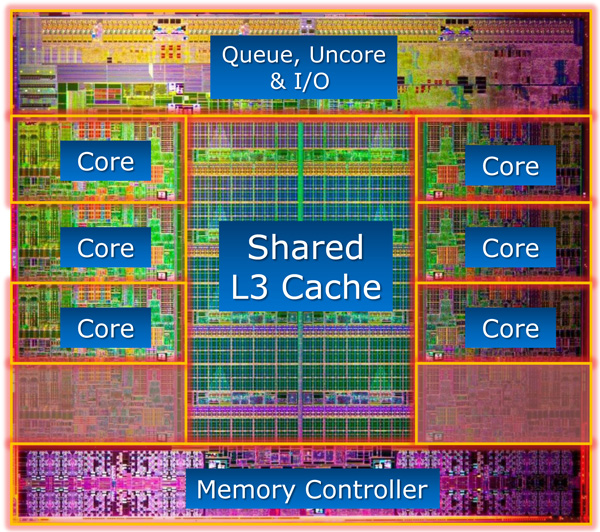Intel Core i7 3960X (Sandy Bridge E) Review: Keeping the High End Alive
by Anand Lal Shimpi on November 14, 2011 3:01 AM EST- Posted in
- CPUs
- Intel
- Core i7
- Sandy Bridge
- Sandy Bridge E
If you look carefully enough, you may notice that things are changing. It first became apparent shortly after the release of Nehalem. Intel bifurcated the performance desktop space by embracing a two-socket strategy, something we'd never seen from Intel and only once from AMD in the early Athlon 64 days (Socket-940 and Socket-754).
LGA-1366 came first, but by the time LGA-1156 arrived a year later it no longer made sense to recommend Intel's high-end Nehalem platform. Lynnfield was nearly as fast and the entire platform was more affordable.
When Sandy Bridge launched earlier this year, all we got was the mainstream desktop version. No one complained because it was fast enough, but we all knew an ultra high-end desktop part was in the works. A true successor to Nehalem's LGA-1366 platform for those who waited all this time.

Left to right: Sandy Bridge E, Gulftown, Sandy Bridge
After some delays, Sandy Bridge E is finally here. The platform is actually pretty simple to talk about. There's a new socket: LGA-2011, a new chipset Intel's X79 and of course the Sandy Bridge E CPU itself. We'll start at the CPU.
For the desktop, Sandy Bridge E is only available in 6-core configurations at launch. Early next year we'll see a quad-core version. I mention the desktop qualification because Sandy Bridge E is really a die harvested Sandy Bridge EP, Intel's next generation Xeon part:
If you look carefully at the die shot above, you'll notice that there are actually eight Sandy Bridge cores. The Xeon version will have all eight enabled, but the last two are fused off for SNB-E. The 32nm die is absolutely gigantic by desktop standards, measuring 20.8 mm x 20.9 mm (~435mm^2) Sandy Bridge E is bigger than most GPUs. It also has a ridiculous number of transistors: 2.27 billion.
Around a quarter of the die is dedicated just to the chip's massive L3 cache. Each cache slice has increased in size compared to Sandy Bridge. Instead of 2MB, Sandy Bridge E boasts 2.5MB cache slices. In its Xeon configuration that works out to 20MB of L3 cache, but for desktops it's only 15MB. That's just 1MB shy of how much system memory my old upgraded 386-SX/20 had.
| CPU Specification Comparison | ||||||||
| CPU | Manufacturing Process | Cores | Transistor Count | Die Size | ||||
| AMD Bulldozer 8C | 32nm | 8 | 1.2B* | 315mm2 | ||||
| AMD Thuban 6C | 45nm | 6 | 904M | 346mm2 | ||||
| AMD Deneb 4C | 45nm | 4 | 758M | 258mm2 | ||||
| Intel Gulftown 6C | 32nm | 6 | 1.17B | 240mm2 | ||||
| Intel Sandy Bridge E (6C) | 32nm | 6 | 2.27B | 435mm2 | ||||
| Intel Nehalem/Bloomfield 4C | 45nm | 4 | 731M | 263mm2 | ||||
| Intel Sandy Bridge 4C | 32nm | 4 | 995M | 216mm2 | ||||
| Intel Lynnfield 4C | 45nm | 4 | 774M | 296mm2 | ||||
| Intel Clarkdale 2C | 32nm | 2 | 384M | 81mm2 | ||||
| Intel Sandy Bridge 2C (GT1) | 32nm | 2 | 504M | 131mm2 | ||||
| Intel Sandy Bridge 2C (GT2) | 32nm | 2 | 624M | 149mm2 | ||||
Update: AMD originally told us Bulldozer was a 2B transistor chip. It has since told us that the 8C Bulldozer is actually 1.2B transistors. The die size is still accurate at 315mm2.
At the core level, Sandy Bridge E is no different than Sandy Bridge. It doesn't clock any higher, L1/L2 caches remain unchanged and per-core performance is identical to what Intel launched earlier this year.
The Lineup
| Processor | Core Clock | Cores / Threads | L3 Cache | Max Turbo | Max Overclock Multiplier | TDP | Price |
| Intel Core i7 3960X | 3.3GHz | 6 / 12 | 15MB | 3.9GHz | 57x | 130W | $990 |
| Intel Core i7 3930K | 3.2GHz | 6 / 12 | 12MB | 3.8GHz | 57x | 130W | $555 |
| Intel Core i7 3820 | 3.6GHz | 4 / 8 | 10MB | 3.9GHz | 43x | 130W | TBD |
| Intel Core i7 2700K | 3.5GHz | 4 / 8 | 8MB | 3.9GHz | 57x | 95W | $332 |
| Intel Core i7 2600K | 3.4GHz | 4 / 8 | 8MB | 3.8GHz | 57x | 95W | $317 |
| Intel Core i7 2600 | 3.4GHz | 4 / 8 | 8MB | 3.8GHz | 42x | 95W | $294 |
| Intel Core i5 2500K | 3.3GHz | 4 / 4 | 6MB | 3.7GHz | 57x | 95W | $216 |
| Intel Core i5 2500 | 3.3GHz | 4 / 4 | 6MB | 3.7GHz | 41x | 95W | $205 |
Those of you buying today only have two options: the Core i7-3960X and the Core i7-3930K. Both have six fully unlocked cores, but the 3960X gives you a 15MB L3 cache vs. 12MB with the 3930K. You pay handsomely for that extra 3MB of L3. The 3960X goes for $990 in 1K unit quantities, while the 3930K sells for $555.
The 3960X has the same 3.9GHz max turbo frequency as the Core i7 2700K, that's with 1 - 2 cores active. With 5 - 6 cores active the max turbo drops to a respectable 3.6GHz. Unlike the old days of many vs. few core CPUs, there are no tradeoffs for performance when you buy a SNB-E. Thanks to power gating and turbo, you get pretty much the fastest possible clock speeds regardless of workload.
Early next year we'll see a Core i7 3820, priced around $300, with only 4 cores and a 10MB L3. The 3820 will only be partially unlocked (max OC multiplier = 4 bins above max turbo).


















163 Comments
View All Comments
SonicIce - Monday, November 14, 2011 - link
cool good review.wharris1 - Monday, November 14, 2011 - link
It would be interested to test the OC'd SBE vs an OC'd SB; I suspect that the 2x advantage of the SBE would fall back in line to around the ~30-40% speed advantage seen in non-OC'd testing (in heavily threaded workloads). I have the feeling that between being defective xeon CPU parts and lacking more SATA 6Gbs as well as USB 3.0 functionality on the motherboard side, this release is a bit hamstrung. I be that with the release of Ivy Bridge E parts/motherboards, this combo will be more impressive. Part of the problem is that the regular SB parts are so compelling from a price/performance perspective. As always, nice review.Johnmcl7 - Monday, November 14, 2011 - link
I thought that odd as well as it almost implies the regular Sandybridge processors are poor overclockers when there are results for the new processor overclocked and Bulldozer overclocked. I guess though it's more it would be interesting to see rather than actually change anything, I currently have an i7 960 and was hoping for an affordable six core processor but it's looking like I'll wait until Ivybridge nowTunnah - Monday, November 14, 2011 - link
although i can understand the expectation of all 6 ports being sata 3, maybe the reasoning is implementing it would probably be pointless for 99.9% of users - i can't even begin to imagine any none-enterprise usage for 6 SSDs running at max speed!Exodite - Monday, November 14, 2011 - link
While I personally don't disagree with most people not needing more than two SATA 6Gbps ports you have to keep in mind that 99.9% of all users have no need for the SB-E /platform/ in its entirety.Since it's squarely aimed at workstation power users and extreme-end enthusiasts, those last 0.1% of users if you will, offering more SATA 6.0Gbps ports makes sense.
Zoomer - Monday, November 14, 2011 - link
I can't imagine the area difference being an issue. Like, are sata3 controllers really that different once it was already done and validated? Having two types of sata controllers on chip seems redundant to me. It's like PCIe 1.0 vs 2.0; once you have the 2.0 implementationd one, there's no reason to have 1.0 only lanes since it is backwards compatible.Jaybus - Tuesday, November 15, 2011 - link
The reason for keeping SATA 3Gbps and PCIe 1.0 is not a die area issue or lack of reasoning. SATA 6Gbps takes considerably more power than 3Gbps, and PCIe 2.0 likewise consumes more power than 1.0. It's simply the physical reality of higher transfer rates. SB-E is already at 130 W, so there simply isn't room in the power envelope to make every interface the highest speed available.MossySF - Tuesday, November 15, 2011 - link
We ran into this problem. Our data processing database has 1 slow SSD for a boot drive and 5 x Sandforce SATA3 SSDS in a RAID0 array ... and we can't do even half the speed the SSDs can run at.You might say why would a non-enterprise user being using this many SSDs? Uh, why would a non-enterprise user be running this obscenely fast computer? You need this much speed to play Facebook Farmville?
ltcommanderdata - Monday, November 14, 2011 - link
Given Ivy Bridge is coming in a few months, perhaps you could comment whether SB-E is worth it even for power users at this time? Has there been indications that high-end Ivy Bridge will likewise launch much later than mainstream parts? Is LGA 2011 going to be around a while or will it need to be replaced if high-end Ivy Bridge decides to integrate an IGP for QuickSync support and as an OpenCL co-processor?DanNeely - Monday, November 14, 2011 - link
I don't think Intel's spoken publicly about IB-E yet.That said, Intel hasn't done socket changes for any of the other recent die shrinks so I doubt we'll see one for ivy. Incremental gains in clock speed, and possibly pushing more cores down to lower price points ($300 6 core, or $1000 8 core) are the most likely results.
OTOH if its launch is as delayed as SB-E's was Haswell will be right around the corner and there will again be the risk of the new quad core wiping the floor with the old hex for most workloads.